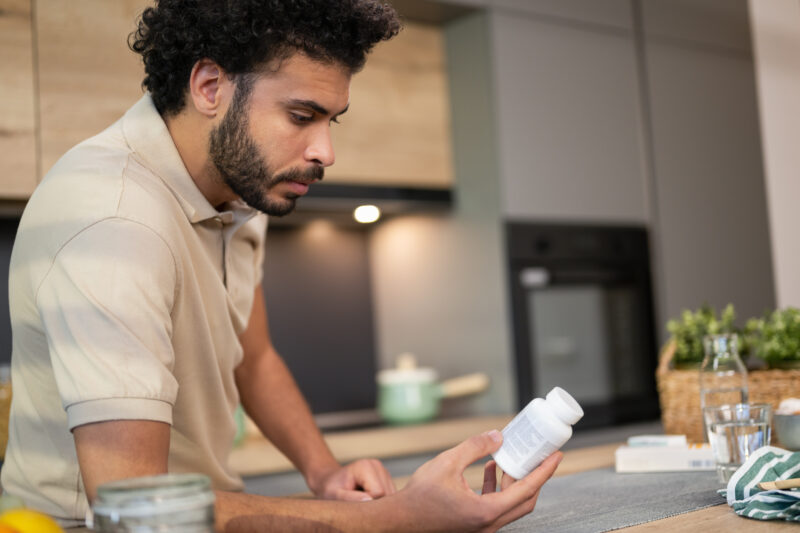
Table of Contents
What to Know About Taking Naltrexone for Alcohol Use Disorder

Written By: Ashley Laderer

Clinically Reviewed By: Erin Husting
May 7, 2025
7 min.
If you or a loved one is struggling with alcohol use disorder (AUD), medication-assisted treatment (MAT) can help. Read on to learn about taking naltrexone for AUD.
Learn more about our Clinical Review Process
Table of Contents
Alcohol use disorder (AUD) is extremely common in the United States. Nearly 29 million people ages 12 and older struggled with the condition in 2023 alone. When left untreated, AUD can be very dangerous and even lead to death. This is why taking action and seeking treatment is absolutely essential. Thankfully, there are many different treatment options to help someone recover from alcohol dependence and stay sober — including taking naltrexone, a medication that’s FDA-approved for treating both AUD and opioid use disorder. This medication can play an important role in recovery for people on a journey to sobriety. Read on to learn about taking naltrexone for alcohol use disorder, including how it works, its side effects, how it compares to other medications for AUD, and more.

Virtual medication-assisted treatment (MAT) for substance use disorder (SUD)
Our virtual programs integrate MAT, where offered, with a specialized SUD therapy program to support long-term recovery.
How is naltrexone used for alcohol use disorder?
Naltrexone is a medication meant to help people with AUD stop drinking alcohol. “Naltrexone reduces alcohol cravings and decreases the pleasurable effects of drinking, which can help the individual reduce alcohol consumption, cravings, and maintain abstinence,” says Nicole Lonano, MS, a Charlie Health Group Facilitator.
If you know that drinking alcohol won’t make you feel good, you won’t want to drink it, since you won’t be reaping any rewards. This helps you maintain control over your drinking and avoid relapsing after you detox from alcohol and are trying to stay sober.
However, it’s important to note that naltrexone is not a standalone treatment for AUD, and mental health treatment alongside medication-assisted treatment (MAT) is very important. “Therapy is an essential aspect that complements naltrexone in the treatment of AUD by addressing the psychological, behavioral, and social elements of addiction that medication alone cannot treat,” says Dr. Shanard Clemons, Ed.D, LAPC, NCC, a Charlie Health Group Facilitator.
How does naltrexone for alcohol use disorder work?
“Naltrexone’s mechanism of action principally includes the blockade of opioid receptors in the brain, specifically the mu opioid receptor,” says Dr. Clemons. “By attaching to these receptors without activating them, it blocks endogenous opioids, such as endorphins, and exogenous opioids, such as morphine or heroin, from doing so.”
To break that science down for you in simpler terms: everyone’s brain has receptors that respond to chemical messengers known as neurotransmitters. When a neurotransmitter binds to these receptors, it makes you feel certain things.
When a person consumes alcohol, feel-good neurotransmitters called endorphins are released and connect to these receptors, causing feelings of pleasure and euphoria, Dr. Clemons explains. Plus, it makes drinking feel rewarding and makes you want to keep drinking more.
These endorphins bind to opioid receptors in the brain. But when you take naltrexone, the medication blocks those receptors, so you don’t feel the pleasurable, rewarding effects of alcohol. In general, this helps people abstain from alcohol, Lonano says. This medication is also FDA-approved for opioid use disorder, working in the same way, blocking the positive effects of opioid drugs.
How do you get a prescription for naltrexone?
Naltrexone is only available by prescription. “Patients can receive a naltrexone prescription by consulting with a doctor, nurse practitioner, physician assistant, or addiction specialist,” says Dr. Clemons. “This can be done through a primary care provider, a mental health or addiction treatment clinic, or Telehealth providers that specialize in substance use disorders.”
Your provider will determine if you’re a good fit for naltrexone, considering your overall health. Additionally, they will ask questions about whether you’re taking any opioids. It’s important to be honest about this for your own safety. You should not take naltrexone if you’ve had any opioid use within the last 7-10 days.
Naltrexone is available in two forms: oral pill and injection. Your provider will determine whether you’re a better fit for either oral or injectable naltrexone.
What are the side effects of naltrexone?
As with any other medication, naltrexone comes along with a risk of side effects, including:
- Headache
- Dizziness
- Anxiety and nervousness
- Drowsiness
- Nausea and vomiting
- Stomach pain
- Loss of appetite
- Joint or muscle pain
This is not an exhaustive list of side effects. You can see more here. Additionally, there is a risk of serious side effects, including:
- Blurred vision
- Hallucinations
- Confusions
- Severe diarrhea or vomiting
If you encounter any of these while taking naltrexone, it’s important to tell your provider immediately.
What other medications are used for alcohol addiction?
There are three FDA-approved medications for the treatment of AUD: naltrexone, acamprosate, and disulfiram. Now that you know how naltrexone works and what it does, let’s dive into the other two.
1. Acamprosate
This medication acts on the glutamate and GABA systems in your brain, says Dr. Clemons. Drinking alcohol, especially excessively and chronically, significantly impacts these systems and affects balance within your brain. When you take acamprosate, it restores the balance damaged by prolonged alcohol use, Dr. Clemons says. Simply put, it helps your brain chemistry return to a more “normal” place, helping you feel better. It may also help reduce alcohol cravings.
2. Disulfiram
This medication blocks aldehyde dehydrogenase, which is a chemical in your body that helps break down alcohol. With this chemical blocked, your body can’t properly break down alcohol. This makes drinking physically unpleasant, resulting in symptoms like flushing, nausea, and heart palpitations, Dr. Clemons says.
How does naltrexone compare to other medications used for alcohol addiction?
Naltrexone
Acamprosate
Disulfiram
How it works: Blocking “feel-good” effects of alcohol
What happens if you drink on it: Alcohol doesn’t feel as good or rewarding
How often to take it: Daily, once a day for oral naltrexone, or once a month for the naltrexone injection
How it works: Helping your brain feel more balanced after you stop drinking
What happens if you drink on it: Won’t cause a reaction
How often to take it: Daily, three times a day
How it works: Blocking your body from breaking down alcohol, making you feel sick
What happens if you drink on it: You will feel negative symptoms, including flushing, headache, rapid heartbeat, nausea, and vomiting
How often to take it: Daily, once a day
Here are some considerations to keep in mind about the three FDA-approved medications for treating AUD.
Naltrexone
- How it works: Blocking “feel-good” effects of alcohol
- What happens if you drink on it: Alcohol doesn’t feel as good or rewarding
- How often to take it: Daily, once a day for oral naltrexone, or once a month for the naltrexone injection
Acamprosate
- How it works: Helping your brain feel more balanced after you stop drinking
- What happens if you drink on it: Won’t cause a reaction
- How often to take it: Daily, three times a day
Disulfiram
- How it works: Blocking your body from breaking down alcohol, making you feel sick
- What happens if you drink on it: You will feel negative symptoms, including flushing, headache, rapid heartbeat, nausea, and vomiting
- How often to take it: Daily, once a day
How can therapy complement naltrexone treatment?
“While naltrexone lessens cravings and the rewarding effects of alcohol, it does not teach coping skills, treat underlying emotional disorders, or aid in the restoration of a sober lifestyle. This is why attending therapy is imperative,” Dr. Clemons says.
Mental health conditions commonly co-occur alongside AUD, especially:
- Generalized anxiety disorder (GAD)
- Social anxiety disorder (SAD)
- Panic disorder
- Depression
- Bipolar disorder
- Post-traumatic stress disorder (PTSD)
- Other substance use disorders
Treating these underlying conditions can make a big difference in recovering from AUD, as many people use alcohol as a way to self-medicate and improve symptoms. However, this results in a vicious cycle that really just ends up worsening mental health symptoms and leading to more drinking, and so on.
Even if you don’t have a co-occurring mental health condition, therapy can help you address any other underlying psychological and other behavioral factors contributing to alcohol use, Lonano says. “Individuals can explore the reasons behind their alcohol use, including emotional pain, trauma, and other social pressures,” she adds.
Not to mention, Lonano says therapy can help you:
- Build coping skills to address triggers
- Learn tools to manage cravings
- Get support and guidance to navigate the challenges of recovery
- Maintain long-term sobriety
Types of therapy for AUD
Various therapy modalities can help people with AUD, including:
1. Cognitive behavioral therapy (CBT)
CBT can help you identify and change negative thought patterns and address unhealthy behaviors. In the context of AUD, you can learn what types of thoughts contribute to your alcohol abuse and develop healthier ones.
2. Motivational interviewing (MI)
MI helps you identify your personal motivation for change — in this case, getting sober. You will gain confidence that you can make meaningful change for good and overcome ambivalence (or mixed emotions) around getting sober.
3. Dialectical behavior therapy (DBT)
DBT is a skills-based therapy rooted in mindfulness and acceptance. You will learn emotional regulation and distress tolerance skills that help you manage difficult feelings in healthy ways, rather than turning to alcohol or other substances. There’s also a focus on developing healthier relationships.
4. Family therapy
Family therapy can be very helpful for recovery, especially when a teen has AUD. Research shows it leads to improved treatment outcomes and long-term recovery. The therapist will work both with the individual and family members to develop healthier habits and communication skills.
5. Peer support groups for alcohol use disorder
Although not technically therapy, peer support groups play a key role in recovery for many people with AUD. These groups provide you with a sense of community — a chance to connect with people who are going through exactly what you’re going through. Here, you can learn from each other and hold one another accountable in sobriety. Examples are:
- Alcoholics Anonymous (AA)
- Refuge Recovery
- Yoga 12-step Recovery (Y12SR)
- SMART Recovery
Paired with therapy, groups like these can help you get and stay sober.

How Charlie Health can help
If you struggle with alcohol use disorder, Charlie Health can help. Our virtual Intensive Outpatient Program (IOP) provides more than once-weekly mental health treatment for people dealing with serious mental health conditions, including AUD and co-occurring disorders.
Our compassionate clinicians meet you where you are on your recovery journey. We incorporate evidence-based therapies, like CBT, DBT, and motivational interviewing, into individual counseling, family therapy, and group sessions. An IOP is a great option for those who want to recover from alcohol use disorder and need more support than weekly therapy, but don’t require the 24/7 monitoring of inpatient care. With this kind of support, recovery is possible. Fill out the form below or give us a call to start your sobriety journey today.
References
https://www.niaaa.nih.gov/alcohols-effects-health/alcohol-topics/alcohol-facts-and-statistics/alcohol-use-disorder-aud-united-states-age-groups-and-demographic-characteristics
https://medlineplus.gov/druginfo/meds/a685041.html
https://www.niaaa.nih.gov/sites/default/files/publications/video-RSA2017/Mason_508.pdf
https://www.ncbi.nlm.nih.gov/books/NBK64031/
https://medlineplus.gov/druginfo/meds/a604028.html
https://www.ncbi.nlm.nih.gov/books/NBK459340/
https://www.niaaa.nih.gov/health-professionals-communities/core-resource-on-alcohol/mental-health-issues-alcohol-use-disorder-and-common-co-occurring-conditions
https://pmc.ncbi.nlm.nih.gov/articles/PMC8104924/





